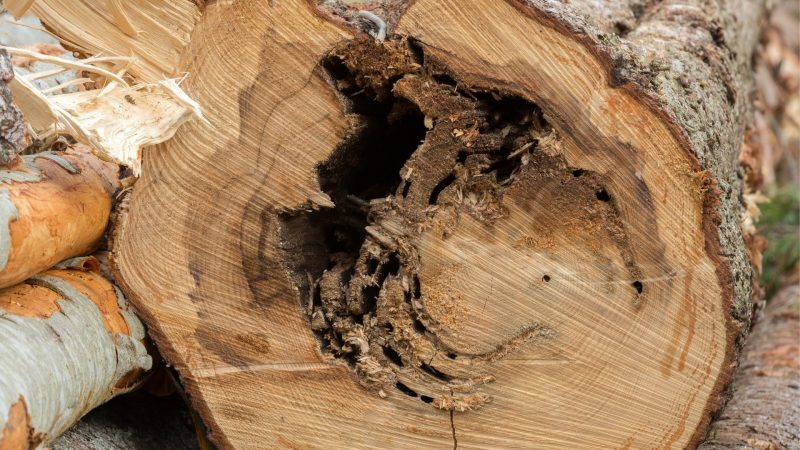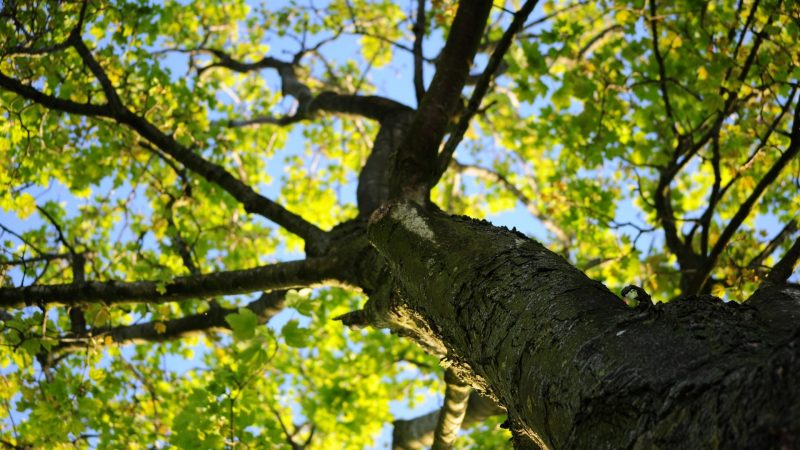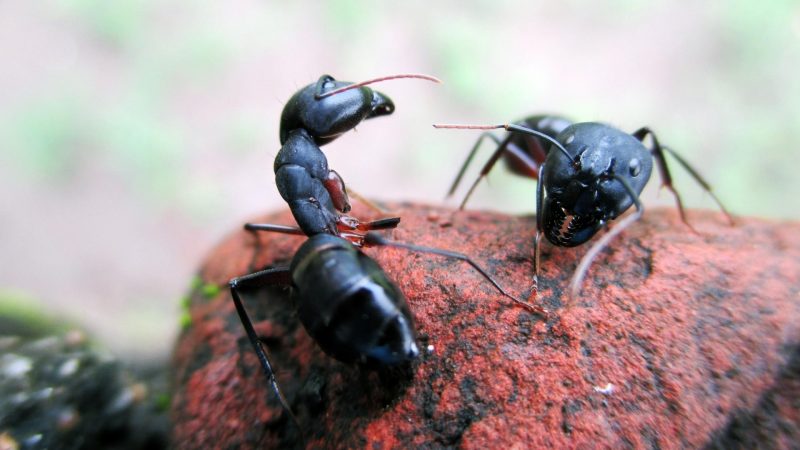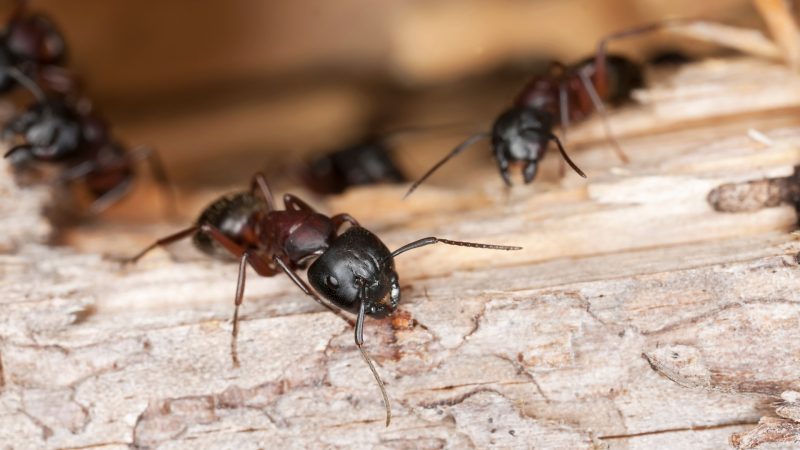The carpenter ants live primarily in rotten and decaying wood and are most active during spring and summer. They feed on dead or alive insects, and their main food sources are protein and sugar. But they pose a significant danger to trees as the damage from their excavations can in some cases become permanent.
How to get rid of carpenter ants in trees? Look for wood shavings and holes in the tree as they are entry points of their nests. Next, use powder or liquid insecticide and apply it thoroughly on the nest. In addition, place a few ant baits around the tree or on the ant trails to take care of any satellite nests.
In the following sections, we went more in-depth about signs of a carpenter ant infestation in your trees and also provided a step-by-step guide with products for their eradication. Let’s begin!
What Is a Carpenter Ant?
Carpenter ants are named for their propensity for dwelling in and quickly tunneling through wood. The spring and summer seasons are when carpenter ants are most busy.
The size of a carpenter ant distinguishes it from other species. They range in size from 1/2″ to 5/8″. Additionally, most carpenter ants are red-black, all-red, all-black, or all-brown.
Carpenter ant colonies can number between 20,000 and 50,000 ants at one time, making them fairly big. To lay their eggs, they dig in locations with a lot of moisture. They can be found both inside and outside, and are generally found in places with rotting wood.
Carpenter Ants in Trees | Information
Carpenter ants use rotting, decaying, or dead trees to build their nesting areas because they need a higher amount of moisture for their eggs to survive.
Reasons for your decaying trees can be different diseases, mechanical damage (from a lawnmower that bumped into the trunk, for example), environmental conditions (such as cold weather, lightning strike, or strong winds), weak branches, and so on.
Whatever the cause for the initial damage, once the tree starts decaying, it becomes the perfect environment for the carpenter ants to settle in.
Do Carpenter Ants Harm Trees?

Carpenter ants do not initially harm the tree but they are responsible for further damage to an already weakened or decaying tree. Once a tree or a section of a tree has been injured – by stress, environmental factors, disease, or other pests and animals, and wood decay starts, carpenter ants use that as an opportunity to colonize the tree.
They take advantage of the softened wood and the moisture and start to build their nests. Even though these ants are not the primary reason for the decaying of the tree, they can further extend the damage as the tree might lose its natural strength to recover.
Related: Ants in Garden: Are Ants Good for Plants in Your Garden?
Do Carpenter Ants Nest in Trees?
Carpenter ants are a wood-nesting ant species. They usually create their tunnels just a few feet off the ground in the trees as they prefer moist and humid environments. The queen, workers, eggs, and newly-hatched eggs reside in the primary nest.
Once the primary nest has been established and begins to mature, the colony starts to build satellite nests. This is where older larvae, pupae, and winged ants reside. Since there are no eggs in the satellite nests, they can be built in relatively dry environments.
Why Are Carpenter Ants Eating My Tree?
Carpenter ants do not actually eat the tree, they just chew through it while creating different tunnels and chambers they use to travel through. The chewed wood (also known as frass) is discarded by the ants. This is why seeing piles of wood shavings near a tree is a sure sign that there is a carpenter ants colony inside.
What Are the Signs of Carpenter Ants in Trees?
Usually, carpenter ants enter the tree through an already existing hole such as a woodpecker hole, a crack in the bark, a hole created from mechanical damage, or through tunnels made from other insects.
Once there is an opening in the wood, it becomes softer due to moisture and easier for the ants to chew through. Apart from visible holes and openings in the bark, another typical sign of an infestation of carpenter ants in trees is the piles of sawdust that are being ejected from the nest.
Threats of Carpenter Ants
Carpenter ants can be uncomfortable, but they don’t pose a serious threat to your health because they don’t transmit disease. Additionally, they don’t bite frequently and their bites aren’t deadly.
However, they might pose a serious hazard to the foundation of your house. They make their nests by hollowing out wood, so if they sneak into your home’s wall voids and remain there unnoticed, they could seriously harm your home.
Will Carpenter Ants Kill My Tree?
Carpenter ants can nest in a seemingly healthy tree for years and use only the dead tissue to build their tunnels and galleries. This way they can go unnoticed for a long time until eventually, the state of the tree starts to become worse.
Carpenter ants will not kill the tree themselves but because of them it will not be able to recover naturally and its condition will deteriorate over time. This is why it is very important to keep your trees healthy, inspect often for signs of infestation and ant nests, and take immediate measures to deal with the problem.
Types of Trees That Carpenter Ants Prefer
Although carpenter ants can most commonly be found in standing dead trees and stumps, it’s not uncommon for them to create nests in living trees, as long as it has suitable conditions. They represent a serious problem in natural forests as well.

Some of the trees carpenter ants prefer include sugar maple, oak, cherry, plum, peach, almond, sweetgum, pine tree, northern white cedar, and balsam fir. One of the reasons carpenter ants are attracted to these types of trees is because of aphids, which ants use for food.
How to Recognize a Carpenter Ants Infestation on Trees?
Carpenter ants are relatively large and their length varies from ¼ to ⅜ inches. Most commonly they are dark brown to black colored, but there are also red or yellow carpenter ants. Carpenter ants are of a different size in a colony depending on their role, for example, the queen is slightly bigger than the workers.

The average carpenter ant colony contains around 20 000 workers, but larger colonies can easily be up to 50 000 workers. So getting rid of carpenter ants on time is important to prevent them from expanding to multiple colonies. A carpenter’s ant infestation in your trees can easily get out of control.
Before everything else, you need to know how to spot the signs of a carpenter ants infestation in trees:
Piles of Sawdust
Piles of sawdust can also often be found at the base of the tree. Search for an ant nest close to the base of the tree but keep in mind that most carpenter ants build their nests inside the wood so most likely you will see just the opening of the nest.
Carpenter ants need moist, humid environments, and they build their nests in decaying, damp wood. So by not paying proper attention to the health of your trees, you are increasing the chances of having a carpenter ant infestation.
Rapid Deterioration of Trees
The most easily recognizable sign of a carpenter ants infestation in trees is the rapid deterioration. In most cases, carpenter ants can live in the tree for a long time without any health problems for the tree.
They don’t do the initial damage to the tree but they are real opportunists and will infest a tree that was already previously damaged or in a state of decay. Have in mind that if the infestation is already happening for a while it might be more difficult to handle it and the tree damage could stay permanent.
If you are unsure how to recognize and deal with a carpenter ants infestation in your trees, your best bet is to call a professional pest control service. Have an expert examine your garden, and identify the signs, and the extent of the infestation. They will remove the carpenter ants with ease.
How to Get Rid of Carpenter Ants in Trees: Step-by-Step Instructions

It is not easy to get rid of carpenter ants once the infestation has progressed. The only way to get rid of them completely is to find and destroy their nests. Finding their nests can sometimes be hard but no worries, we will guide you through this process. The following is our step-by-step guide on how to get rid of the carpenter ants in trees:
Step 1: Locating the Carpenter Ant’s Nest on the Tree
Locate the carpenter’s ant colony and find the holes that the ants use to enter the nest. If you don’t see the opening of the nest, use a scraper to dig around the base of the tree. When you see a lot of ants coming out from one place, that is most likely the nest.
Step 2: Appropriate Insecticide | Liquid, Dust, or Baits
Once you have found the nest, it is time to apply some form of insecticide. You can either use dust (powder) or liquid insecticide. There are also ant baits but we are going to talk about them in the next section.
If you are planning on using insecticide dust or powder for carpenter ants, spread it evenly around the entrance of the colony.
- Effectively Kills Insects - Kills ants (including fire &...
- Waterproof Formula - The waterproof dust won't wash in the rain
- Fast Acting & Long Lasting - This dust kills insects on contact...
- Easy to Apply - The convenient shaker canister allows for both...
- Use Indoors & Outdoors - Apply in cracks and crevices, around...
- Attracts & Kills - These granules bait and kill ants,...
- Long Lasting - The weather-resistant granules provide...
- Keeps Insects Out - These outdoor granules take care of insect...
- Easy to Use - The convenient 2 lb shaker canister allows for easy...
- For Outdoor Use - Ideal for use as a perimeter application around...
- Excellent Carpenter Ant Control: As social insects, ants live in...
- Highly Effective: Active ingredient Abamectin 0.011%; Delayed...
- Kills Listed Ants: Including many common varieties of household...
- Read, understand and follow label safety and application...
The powder will kill the ants who touch it and will poison the other ants who will try to carry the dead ones back into the nest. This is an easy and effective method to get rid of carpenter ants. Just remember to reapply the dust in case of rain as the water will remove it from the tree.
If you opt for liquid carpenter ant insecticide spray or soak the nest thoroughly and then the tree starting at the bottom and working your way up the trunk.
- Broad-Spectrum Pest Control: Targets more than 30 common pests...
- Formulated with iCAP Technology: This sprayable insecticide...
- Durable Under Extreme Conditions: Formulation remains intact...
- Easy-Mix Formula: This insecticide concentrate is easily mixed...
Cover as much area as possible as ants will try to escape under the ground and around the edges. If you succeed in spraying the nest well from the inside, you might kill it entirely. The main goal is to kill the queen after she dies the colony becomes helpless.
Related: Best Natural Ant Sprays | Kids and Pet-Friendly Sprays
Ant Baits for Carpenter Ants
Is an alternative method that takes time to work but in our opinion, it is probably the most effective one. You can place carpenter ant baits around the tree and on ant trails.
- CONTROLS 25 SPECIES OF ANTS like acrobat ants, Argentine ants,...
- USE ANY TIME ANTS ARE ACTIVE; for best results during hot...
- PREVENT ANTS FROM INVADING YOUR HOME with Amdro Ant Killer for...
- FOR MAXIMUM PROTECTION USE with Amdro Ant Killer Bait Stations or...
- A TRUSTED PARTNER IN PEST CONTROL SINCE 1980; count on Amdro for...
This way you will also get rid of any satellite colonies that might exist in the area. You can either use plastic bait stations or ant stakes. Remember to check the bait systems often as they might need to be replaced.
Before use, make sure to read the instruction manual carefully. Commercial ant baits are very effective and can help you to get rid of any ant infestation effectively but it takes time for them to start working.
Do not use repellent insecticides and bait systems at the same time and in the same area. Since repellent insecticides will drive the ants away from the baits, using both will be useless. If using both methods at the same time and in the same area, make sure that the insecticide you use is non-repellent.
Step 3: Estimate the Tree’s Health
If the tree is beyond salvation, remove it to prevent re-infestation. Otherwise, try to save the tree by killing the ant colony and apply treatment often until you are sure that the colony is completely eradicated.
Step 4: Keeping Track of Other Trees | Regular Inspection
Remember to check the whole area and the surrounding trees to ensure they are in good health and that there are no satellite colonies from the carpenter ants.
Natural Carpenter Ant Treatment for Trees
You can use different natural remedies to get rid of carpenter ants in trees. The following are some of them:
Peppermint Essential Oil
One of the best ways is to use peppermint essential oil since ants hate peppermint. Mix thoroughly 30 drops of peppermint oil in 1 gallon of water.
- CONTROLS 25 SPECIES OF ANTS like acrobat ants, Argentine ants,...
- USE ANY TIME ANTS ARE ACTIVE; for best results during hot...
- PREVENT ANTS FROM INVADING YOUR HOME with Amdro Ant Killer for...
- FOR MAXIMUM PROTECTION USE with Amdro Ant Killer Bait Stations or...
- A TRUSTED PARTNER IN PEST CONTROL SINCE 1980; count on Amdro for...
Spray it all over the tree but focus well on the base of the tree as this is where the nest is most likely located. You need to reapply the solution regularly for several days in order to achieve good results.
Cedar Oil
Cedar oil is another effective way to get rid of carpenter ants as it will dehydrate the ants and in the end result in their suffocation and death.
- 100% Pure & Natural Virginia Cedarwood Oil sourced for its...
- Uncompromised Purity & Potency: Say goodbye to diluted oils! We...
- 100% Pure Virginia Cedarwood Oil: Our product contains only pure...
- UV Protection for Your Essential Oils: Our high-quality glass...
- Customer Satisfaction Guaranteed: We want you to be completely...
Spray cedar oil thoroughly around the tree and its nest and repeat until the problem is under control.
Boric Acid DIY Ant Baits
Another way is to use boric acid which is completely safe for humans but highly toxic to carpenter ants. Mix 1% boric acid and 10% sugar water, or use other sweets or protein-rich foods to prepare this bait.
- Many household uses
- Meets NF standards
- Boric Acid Powder NF 6oz
Ants are going to eat the bait and take it back to the colony to feed the queen and the larvae. Boric acid is a highly potent chemical that will kill the ants, but for the whole colony to die will take some time.
Diatomaceous Earth
Diatomaceous earth is a fine powder produced from algae fossils. It is a natural pesticide and it works great because its abrasive structure can damage the joints and the exoskeleton of the ants. This whole process will eventually kill them.
- OMRI Listed - Listed with the Organic Minerals Research...
- Natural Product - Composed of 10lbs of 100% ground freshwater...
- Vegan-Keto-Gluten Free
- Diatomaceous Earth is a natural source of freshwater amorphous...
You can spread DE on the ants’ nest and all over the base of the tree. It is completely organic and safe for use in gardens. Just keep in mind to buy a food-grade DE as there are several types made for different uses. Do not forget to reapply it after the rain.
Related: How to Get Rid of Carpenter Ants Without an Exterminator
List of Sources
Lewis D., Carpenter Ants in Trees, Iowa State University
Carpenter Ants in Trees, University of Illinois
Carpenter Ants Nesting in Trees and Homes, Michigan State University
Jacobs S., Carpenter Ants, Penn State Extension
Carpenter Ants, Cornell University
Carpenter Ants, US Forest Service – USDA
- How to Get Rid of Copperheads | Practical Guide - August 27, 2023
- How to Get Rid of Corn Snakes | What Makes Them Aggressive? - August 27, 2023
- How to Get Rid of Alligators | Safety Measures and Removal Methods - July 16, 2023








